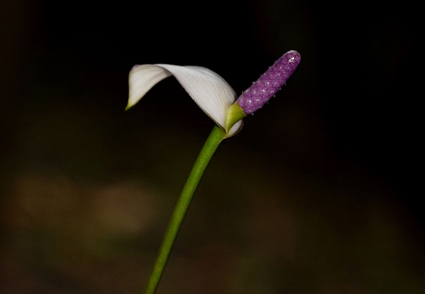Abstract
Anthurium is a highly diverse neotropical genus, in which many species remain undescribed. Here, we describe a new species of Anthurium (sect. Calomystrium, subsect. Rupicola) from Central Peru, which we name Anthurium huaytae. The species is also the first record for subsect. Rupicola for Peru. Anthurium huaytae resembles A. amnicola but differs by its epiphytic habit (vs. epipetric habit), white or light lavender spathe (vs. purple spathe), persistent cataphylls (vs. promptly deciduous cataphylls) and slimmer flowers in relation to its length (ratio 1:1.1) (vs. flowers with a length-width ratio of 2:3). We provide a description, photographs and the floral scent composition of the new species. In addition, an updated identification key including all the known species of Anthurium subsect. Rupicola is also provided.
References
<p>Brako, L. & Zarucchi, J.L. (1993) Catalogue of the flowering plants and gymnosperms of Peru. <em>Monographs in Systematic Botany</em> 45: 1–1286.</p>
<p>Carlsen, M.M. & Croat, T.B. (2013) A molecular phylogeny of the species-rich neotropical genus <em>Anthurium</em> (Araceae) based on combined chloroplast and nuclear DNA. <em>Systematic Botany</em> 38: 576–588. https://doi.org/10.1600/036364413X670287</p>
<p>Carlsen, M.M. & Croat, T.B. (2019) An analysis of the sectional classification of <em>Anthurium</em> (Araceae): comparing infrageneric groupings and their diagnostic morphology with a molecular phylogeny of the genus. <em>Annals of the Missouri Botanical Garden</em> 104: 69–82. https://doi.org/10.3417/2018215</p>
<p>Croat, T.B. (1983) A revision of the genus <em>Anthurium </em>(Araceae) of Mexico and Central America. Part 1: Mexico and Middle America. <em>Annals of the Missouri Botanical Garden</em> 70: 211–417.</p>
<p>Croat, T.B. (1986) A revision of the genus <em>Anthurium</em> (Araceae) of Mexico and Central America. Part 2: Panama. <em>Monographs in Systematic Botany</em> 14: 1–204.</p>
<p>Croat, T.B. (1991) A revision of <em>Anthurium</em> section <em>Pachyneurium </em>(Araceae). <em>Annals of the Missouri Botanical Garden</em> 78: 539–855. https://doi.org/10.2307/2399801</p>
<p>Croat, T.B. & Bunting, G.S. (1979) Standardization of <em>Anthurium</em> descriptions. <em>Aroideana </em>2: 15–25.</p>
<p>Croat, T.B. & Carlsen, M.M. (2020) A new section of <em>Anthurium</em>: section <em>Cordato</em>-<em>punctatum</em> (Araceae), restricted to Central America. <em>Novon</em> 28: 46–50. https://doi.org/10.3417/2019370</p>
<p>Croat, T.B., Whitehill, J. & Yates, E.D. (2007) A new subsection of <em>Anthurium</em> section <em>Calomystrium</em> (Araceae) and five new species from Colombia and Ecuador. <em>Aroideana</em> 30: 23–37.</p>
<p>Delannay, X. & Croat, T.B. (2020) Revision of <em>Anthurium</em> Schott sect. <em>Leptanthurium</em> (Schott) Engl. (Araceae). <em>Aroideana</em> 43: 74–184.</p>
<p>Díaz Jiménez, P., Hentrich, H., Aguilar-Rodríguez, P.A., Krömer, T., Chartier, M., MacSwiney, G.M.C. & Gibernau, M. (2019) A review on the pollination of aroids with bisexual flowers. <em>Annals of the Missouri Botanical Garden</em> 104: 83–104.</p>
<p>Dressler, R. (1980) A new name for the dwarf purple <em>Anthurium</em>. <em>Aroideana</em> 3: 55.</p>
<p>Engler, A. (1905) Araceae, Pothoideae. <em>Das Pflanzenreich</em> 21: 53–295.</p>
<p>Gerlach, G. & Schill, R. (1991) Composition of orchid scents attracting euglossine bees. <em>Botanica Acta</em> 104: 379–384. https://doi.org/10.1111/j.1438-8677.1991.tb00245.x</p>
<p>Hentrich, H., Kaiser, R. & Gottsberger, G. (2010) Floral biology and reproductive isolation by floral scent in three sympatric aroid species in French Guiana. <em>Plant Biology</em> 12: 587–596. https://doi.org/10.1111/j.1438-8677.2009.00256.x</p>
<p>IUCN (2022) <em>Guidelines for using the IUCN Red List Categories and Criteria, version 15.1</em>. Prepared by the IUCN Standards and Petitions Committee, Gland. Available from: http://www.iucnredlist.org/documents/RedListGuidelines.pdf (accessed 28 July 2022)</p>
<p>Martel, C., Rakosy, D., Dötterl, S., Johnson, S.D., Ayasse, M., Paulus, H., Nilsson, A.L., Mejlon, H. & Jersáková, J. (2021) Specialization for tachinid fly pollination in the phenologically divergent varieties of the orchid <em>Neotinea</em> <em>ustulata</em>. <em>Frontiers in Ecology and Evolution</em> 9: 659176. https://doi.org/10.3389/fevo.2021.659176 </p>
<p>Reimuth, J. & Zotz, G. (2020) The biogeography of the megadiverse genus <em>Anthurium</em> (Araceae). <em>Botanical Journal of the Linnean Society</em> 194: 164–176. https://doi.org/10.1093/botlinnean/boaa044</p>
<p>Schott, H.W. (1829) Für Liebhaber der Botanik. <em>Wiener Zeitschrift für Kunst, Literatur, Theater und Mode</em> 3: 828.</p>
<p>Schott, H.W. (1860) <em>Prodromus Systematis Aroidearum</em>. Vindobonae Typis congregationis Mechitharisticae, Vienna, 602 pp.</p>
<p>Thiers, B. (2016) Index Herbariorum: A global directory of public herbaria and associated staff. New York Botanical Garden’s Virtual Herbarium. Available from: http://sweetgum.nybg.org/science/ih/ (accessed 15 January 2023)</p>
<p>WCSP (2022) World checklist of selected plant families. Facilitated by the Royal Botanic Gardens, Kew. Available from: http://apps.kew.org/wcsp/ (accessed 15 July 2022)</p>
<p>Williams, N.H. & Whitten, W.M. (1983) Orchid floral fragrances and male euglossine bees: Methods and advances in the last sesquidecade. <em>Biological Bulletin</em> 164: 355–395. https://doi.org/10.2307/1541248</p>


